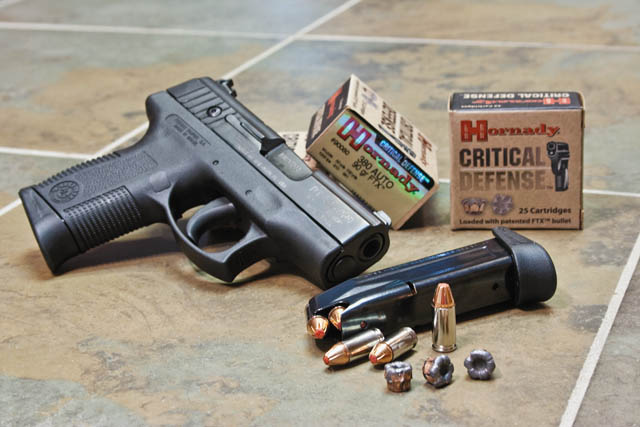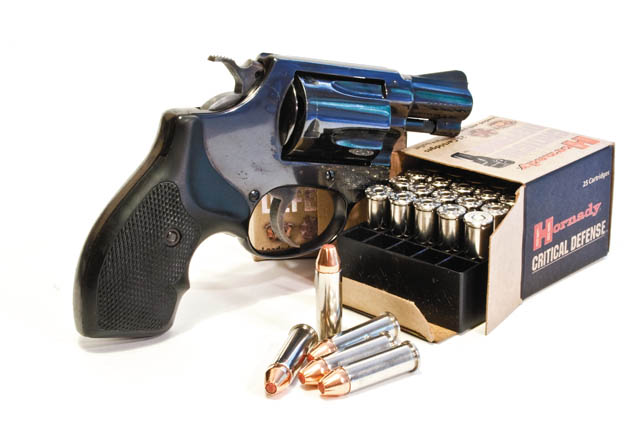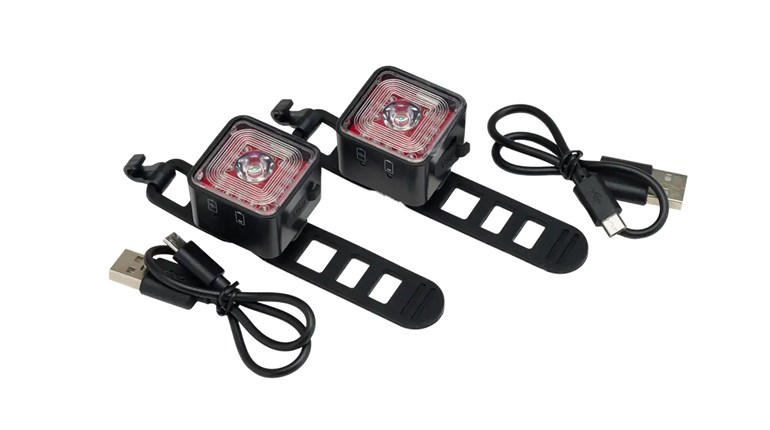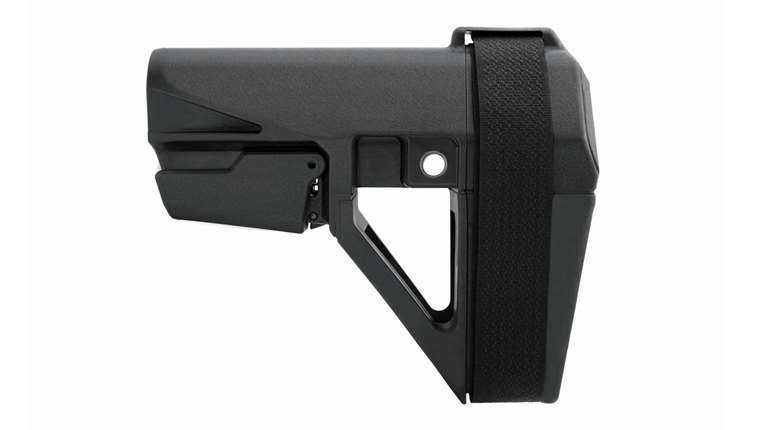
Consumers wonder if a product will perform as advertised. If you purchase a new car that's supposed to get 35 miles to the gallon and you get 27, you'll be ready to backhand your car salesman. Get between 33 and 37 miles per gallon and you'll drive around grinning like the Joker.
Before you pay a $20 for 25 cartridges on which to trust your life, you would probably like to know if they'll perform as advertised. If, through comprehensive testing, I can establish a product meets advertising claims, then all you're left with deciding is if the performance meet your needs. That's how I approached testing Hornady's Critical Defense ammunition. Hornady makes several bold claims about this ammo and, where practical, I conducted tests attempting to validate each one.
Critical Defense ammunition is purpose built for small, defensive handguns. Part of Hornady's incentive had to be that most often, conventional ammunition will not reliably expand from short-barreled handguns due to low muzzle velocities. Another problem with conventional hollow points is, sometimes during penetration they plug with the clothing worn by an attacker. The result is the same—no expansion.
One solution is to make bullets with thin jackets and soft cores. This helps with expansion at low velocity, but can cause excessive expansion and/or fragmentation. Also, fire these bullets out of handguns with longer barrels and the higher velocities can rip them apart on impact. Both equate to limited penetration. Another solution is a wide hollow-point cavity. This works, but some semi-autos will not function reliably with them.
Another less conventional solution is employed by Glaser and Federal. Glaser Pow'RBall bullets are tipped with a rubber ball, but also have a relatively thin jacket and soft core. Federal's EFMJ bullets have a rubber ball inside a hollow-point cavity, underneath a full metal jacket. Both of these loads feed well and deliver reliable expansion.
With Critical Defense ammunition, Hornady took a different approach, but one similar to Pow'RBall and EFMJ bullets. Building from the company's rugged XTP pistol bullet, Hornady added a polymer tip inside the hollow point. This tip is made of the same material used in its LEVERevolution, lever-action rifle ammunition. It calls these mini-creations FTX bullets and the hollow point is already plugged with the tip. Hornady claims this tip initiates expansion and the ammunition is supremely reliable.
Hornady's reliability claim was a good place to start testing, because if ammunition is unreliable, little else matters. I tested .380 ACP and 9 mm Critical Defense loads in a Taurus PT 138 Pro and a CZ 75, firing 100 rounds from each. I experienced only one malfunction, when an empty .380 ACP case—the seventh of 25 shots fired from the bench—was caught in the Taurus ejection port.
The .38 Spl. and .38 Spl. +P loads were tested in a Smith & Wesson Model 36. There were no loading or ejection issues and the pointy bullets made aligning speed loaders easy. In all, 300 rounds of Critical Defense ammunition were fired in three handguns. Every round went bang just like it was supposed to do.
Because they are slicker, I'm sure the nickel cases contribute to the ammunition's reliability in semi-autos. Hornady says nickel cases resist corrosion and are easier to see when doing a press check in low light. That's obvious and you don't need a gun writer to confirm it. Another claim is that bullets are specifically designed for each individual load. This seems obvious too; there's a 90-grain .380 ACP, a 115-grain 9 mm and two 110-grain .38 Spl. loads.
The boldest claim Hornady makes is that the terminal performance of Critical Defense ammunition is, "Unaffected by thick and heavy clothing, including denim and leather." And, "The FTX bullet delivers superior controlled expansion and large, deep wound cavities over a wide range of velocities." This was easy enough to validate in expansion media. Testing was conducted with 10-percent ordnance gelatin and the microcrystalline wax like that used inside the Bullet Test Tube.
All four loads were tested in bare gelatin and penetration ranged from 9 to 10.5 inches. Every bullet expanded. To really stress the bullets, a section of 1.75-inch pine board was placed in front of the gelatin. Penetration with the 9 mm and .38 Spl. loads was practically unchanged, though both bullets tumbled. (Tumbling can occur at random with any bullet at any time.) Both bullets expanded, but not as uniformly as in bare gelatin. The .380 ACP load expanded too, but penetration was substantially reduced by the 2x4.
Continuing the expansion tests, each load was fired into microcrystalline wax without a barrier and using leather, cloth and combinations of both placed in front of the media. The most significant reduction in expansion was with the .380 ACP load and amounted to four percent. This is inconsequential and, in fact, very good performance. Total penetration with all loads was virtually identical to tests in bare media. Cloth and leather barriers did not negatively impact the terminal performance during my testing of Critical Defense ammunition. (For more on how Critical Defense would stack up using FBI bullet-testing protocol, click here.)
This means you can count on Hornady Critical Defense FTX bullets to provide sufficient penetration and expand between 1.3 and 1.6 times their original diameter. Most importantly, you can expect this result regardless of what type clothing the bullet must pass through before it lets the air out of an attacker. In my opinion, this is the ammunition's main strength.
All Critical Defense bullets are cannelured and case crimped to prevent bullet setback. This is important if you unload your pistol every evening and then reload the next morning—chambering the same bullet multiple times. Repeated impact with the feed ramp of a semi-auto can cause bullet setback. A single .380 ACP and 9 mm Critical Defense cartridge was chambered 25 times in both of the test pistols. The overall cartridge length was unaffected at all.
Hornady also claims to use clean-burning propellants in Critical Defense ammunition that reduce both muzzle flash and recoil. The company also says they perform reliably and consistently at all temperatures. Performance at different temperatures was easy to test. A box of each load was placed in the freezer overnight and the frozen ammo average velocities were only 20 to 40 fps slower than those obtained at 85 degrees. The chilled 9 mm load was actually faster by 24 fps. Cold has no affect on Critical Defense ammunition's reliability.
As for recoil reduction, identical bullets at identical velocities produce identical recoil, unless less powder is used in one load than the other. Smaller amounts of a faster-burning powder might be Hornady's approach. This would mean less ejecta and ultimately produce less recoil. Critical Defense ammunition is loaded with bullets on the light side for each chambering, which at standard velocities, mean less recoil than that produced by heavier bullets. This is one claim I could not confirm or refute from a felt-recoil standpoint. That said, none of the loads produced objectionable recoil although more kick was expected with the 38 Spl. +P load.
With regard to the clean-burning powder and reduced muzzle flash, the only way I had to test either was mere observation. I inspected the three handguns after shooting and watched the muzzle flashes in low light, comparing these observations with other ammunition. There is no question that Critical Defense ammunition creates less flash and burns cleaner than many conventional loads, but to what degree I can only speculate.
There's no requirement to carry defensive handgun ammunition that will reliably expand and penetrate deep, but not doing so is about as smart as weaving rattlesnakes. Since individual situations dictate the need for different types of terminal performance, you must decide what's best for you. Hornady's boldest claim is that Critical Defense ammunition is, "The most effective, consistent, and reliable self-defense ammunition available today!" I cannot prove or disprove this declaration, but it certainly does live up to its advertised performance and I am confident it's at least in the running for that title.
After all, it is the holiday season and Rudolph—the best reindeer of them all—had a red nose that was pretty functional, too.







































